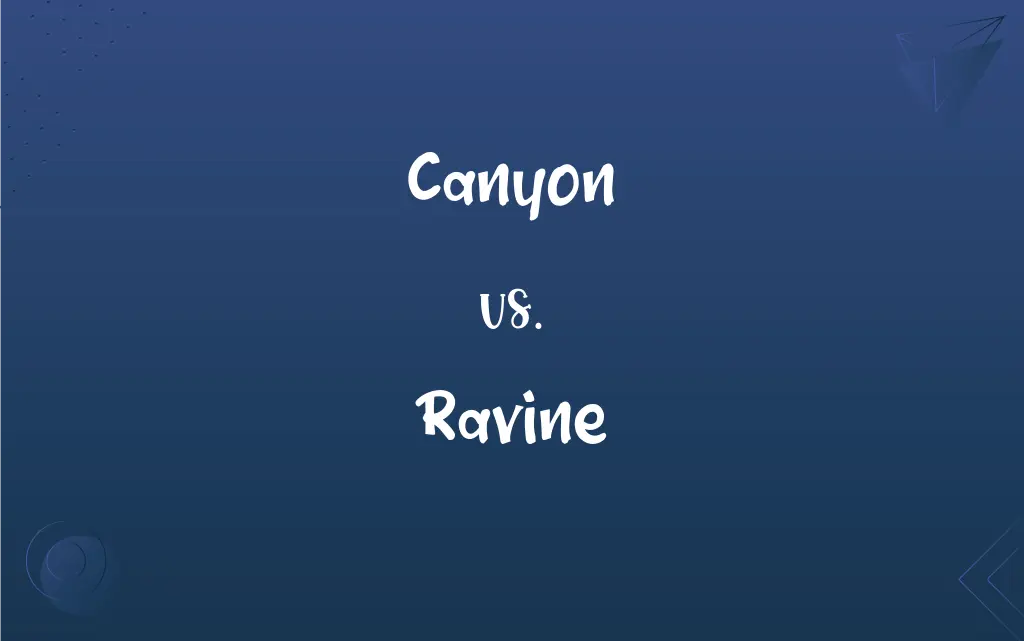Canyon vs. Ravine: What's the Difference?
Edited by Aimie Carlson || By Harlon Moss || Updated on November 2, 2023
A canyon is a large, deep valley with steep sides, often with a river flowing through it, while a ravine is a narrower, smaller valley or gorge, typically without a river.

Key Differences
A canyon is typically a large, deep geological formation with steep sides, often carved from the Earth's surface by a river. Ravines are generally smaller than canyons and are formed by geological processes like erosion but are narrower and may not have a river.
Canyons, such as the Grand Canyon, are vast with a more extensive network of cliffs and ledges, making them significant landmarks. Ravines are often not as expansive and serve more as natural channels for rainwater or streams rather than major rivers.
The formation of a canyon is usually due to long-term erosion from a river, a process that takes millions of years. Ravines might form more quickly, often as the result of heavy rainfall eroding softer soil and rocks.
Canyons can be found in various locations around the world and are often tourist destinations due to their grandeur and geological interest. Ravines, being smaller, may not be as famous or accessible, but they are more commonly encountered in both rural and suburban landscapes.
While both canyons and ravines have steep sides, the term 'canyon' often conveys a sense of grand scale, whereas 'ravine' suggests a more modest-sized gorge that one might encounter while hiking in the wilderness or in the countryside.
ADVERTISEMENT
Comparison Chart
Size
Large and expansive
Smaller and narrower
Formation
Long-term erosion by a river
Erosion by water, often more rapid
Presence of Water
Often contains a river
May or may not have a water stream
Location
Found worldwide, prominent landscapes
More common, found in various terrains
Tourism
Frequently a tourist destination
Less commonly a tourist attraction
ADVERTISEMENT
Canyon and Ravine Definitions
Canyon
A significant natural trench with very steep, cliff-like sides.
They stood at the edge of the canyon, awestruck by its depth.
Ravine
A narrow, steep-sided valley commonly formed by water erosion.
The ravine cut through the landscape, a testament to natural forces.
Canyon
A deep valley with steep sides, often with a river flowing through it.
The Colorado River carved out the vast canyon over millions of years.
Ravine
A lesser canyon without the extensive river system.
We stumbled upon a hidden ravine during our hike in the woods.
Canyon
A feature formed by the erosive activity of a river over a long time period.
The ancient canyon bore the marks of eons of water flow.
Ravine
A chasm or cut in the Earth's surface not as large as a canyon.
The trail followed a rocky ravine filled with wildflowers.
Canyon
A large ravine between pairs of cliffs or escarpments.
The canyon was home to a diverse array of wildlife.
Ravine
A small, deep gorge, especially one worn by running water.
After the storm, the water rushed through the ravine with renewed force.
Canyon
A gorge or ravine, usually with a river, surrounded by mountainous terrain.
The narrow path wound down into the shadowy depths of the canyon.
Ravine
A fissure between two mountains or hills.
The ravine provided a natural boundary between the two territories.
Canyon
A narrow chasm with steep cliff walls, cut into the earth by running water; a gorge.
Ravine
A deep narrow valley or gorge in the earth's surface worn by running water.
FAQs
Can a ravine have a river?
Yes, some ravines may contain small streams or rivers.
Can a canyon have waterfalls?
Yes, canyons can have waterfalls where rivers or streams drop from a height.
Are all ravines part of mountainous regions?
Not all, ravines can be found in various terrains, including flatlands.
Is the Grand Canyon the largest canyon in the world?
It's one of the largest, but not necessarily the largest by all measurements.
Can a ravine become a canyon?
Over time, with significant geological changes, it's possible.
Are ravines formed quickly?
They can form relatively quickly due to processes like heavy rainfall.
Is a ravine bigger than a canyon?
No, ravines are typically smaller and narrower than canyons.
Are canyons only formed by rivers?
Mostly, but other geological processes like volcanic activity can also form canyons.
How are canyons preserved?
Through national parks and conservation efforts.
Do people live in ravines?
It's rare due to the steep and unstable terrain.
What's the role of a ravine in an ecosystem?
It can serve as a drainage channel and habitat.
Are there tours available for canyons and ravines?
There are tours for accessible canyons; ravines are usually explored independently.
Is it possible to hike in a canyon or ravine?
Yes, but the difficulty varies greatly depending on the specific location.
Do canyons always have vertical walls?
Many do, but the slope of canyon walls can vary greatly.
Do ravines have ecosystems?
Yes, they can support diverse plant and animal life.
Can canyons be underwater?
Yes, there are submarine canyons in ocean basins.
What's the difference between a ravine and a creek?
A creek is a small stream, while a ravine is the steep valley it may flow through.
Are there famous ravines?
Yes, but they are less well-known than famous canyons.
Do canyons form in deserts?
Yes, many famous canyons are in arid regions.
Are canyons safe to visit?
Many are, but visitors should always follow safety guidelines.
About Author
Written by
Harlon MossHarlon is a seasoned quality moderator and accomplished content writer for Difference Wiki. An alumnus of the prestigious University of California, he earned his degree in Computer Science. Leveraging his academic background, Harlon brings a meticulous and informed perspective to his work, ensuring content accuracy and excellence.
Edited by
Aimie CarlsonAimie Carlson, holding a master's degree in English literature, is a fervent English language enthusiast. She lends her writing talents to Difference Wiki, a prominent website that specializes in comparisons, offering readers insightful analyses that both captivate and inform.































































